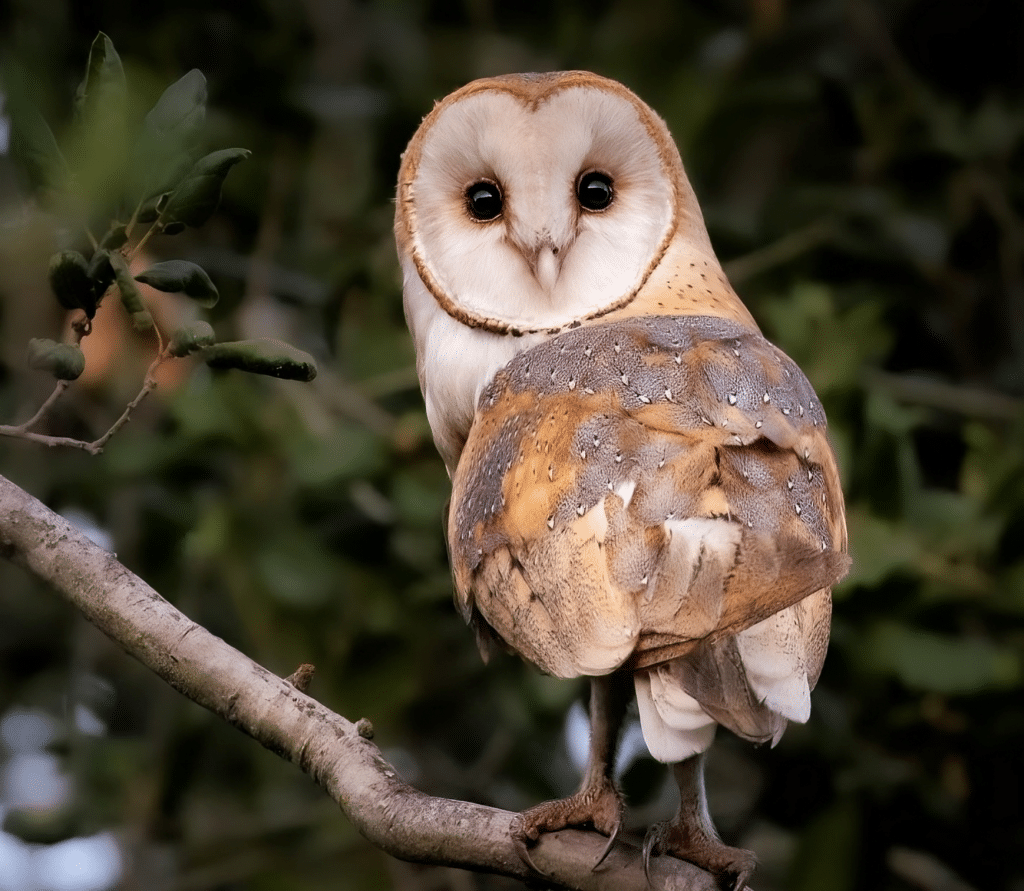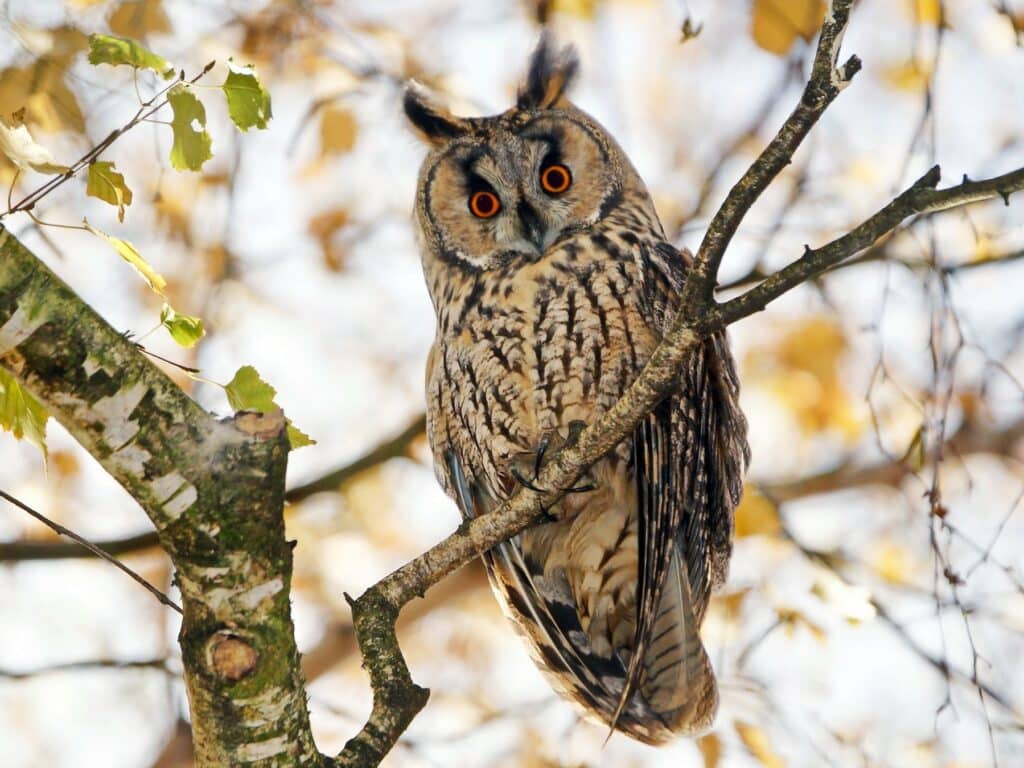The UK is home to a diverse array of bird species, with owls being some of the most captivating and elusive of them all. Often shrouded in mystery and folklore, these nocturnal hunters have been part of British wildlife for centuries, capturing the imagination of many with their enigmatic presence. From the ghostly Barn Owl to the fierce European Eagle Owl, each species brings unique features and behaviours to the rich tapestry of the UK’s avian world.
This article explores six types of owls that can be found in the UK. It delves into their physical characteristics, habitats, feeding habits, and calls, providing a comprehensive insight into the life of these fascinating raptors. Whether you’re an avid birdwatcher, a nature enthusiast, or simply curious about owls, this document aims to offer a deeper understanding and appreciation for these magnificent birds of prey.
1. Tawny Owl (Strix aluco)

The Tawny Owl is the most common owl in the UK, found in woodlands, parks, and gardens. It has a rounded body and head, with a reddish-brown face and underparts. Tawny Owls are mainly nocturnal hunters, feeding on small mammals, birds, and insects. They have a distinctive “twit-twoo” call, which is actually a combination of calls from the male and female. The Tawny Owl is a resident species in the UK, meaning they do not migrate and can be found all year round.
Appearance:
- Medium-sized, around 37-43cm in length.
- Reddish-brown mottled plumage with a pale face and dark eyes.
- Rounded head with no ear tufts.
Habitat:
- Woodlands, parks, and gardens.
- Nests in tree hollows or nest boxes.
- Resident year-round.
Diet:
- Mainly small mammals and rodents.
- Hunts at night, catching prey on the ground or in flight.
- Occasionally takes birds and insects.
Breeding:
- Lays 2-3 eggs, incubated for about 30 days.
- Chicks fledge at around 5-6 weeks of age.
- Young owls depend on parents for several weeks after fledging.
Fun Fact:
The Tawny Owl’s ‘twit-twoo’ call is actually a combination of the female’s sharp ‘kewick’ and the male’s responding ‘hoo-hoo’.
2. Barn Owl (Tyto alba)

The Barn Owl is one of the most iconic owls in the UK, recognised by its heart-shaped facial disc and white underparts. It is found in open countryside, preferring areas with grassland and marshes for hunting. Barn Owls hunt at dusk and dawn, using their exceptional hearing to locate small mammals like voles and shrews. Their ghostly appearance and eerie screeching call make them a popular subject in folklore and myths.
Appearance:
- Medium-sized, around 33-39cm in length.
- Heart-shaped face, white underparts, and golden-brown upperparts.
- Large black eyes.
Habitat:
- Farmland, grassland, and open countryside.
- Nests in barns, church towers, and tree hollows.
- Resident year-round, but may roam in search of food.
Diet:
- Mainly small mammals, especially voles and mice.
- Hunts silently, flying low over open ground.
- Swallows prey whole, regurgitating indigestible parts.
Breeding:
- Lays 4-6 eggs, incubated for about 30-31 days.
- Chicks fledge at around 8-10 weeks of age.
- Parents continue to feed young for several weeks after fledging.
Fun Fact:
Barn Owls are sometimes called “ghost owls” because of their silent flight and pale appearance.
3. Little Owl (Athene noctua)
The Little Owl is a small, stocky owl with a rounded head, found in open countryside, parkland, and gardens. It has a mottled brown and white plumage with a distinctive white “eyebrow” above its large yellow eyes. Little Owls are active during the day and can often be seen perched on a post or tree stump. They feed on insects, small mammals, and birds. The Little Owl was introduced to the UK from mainland Europe in the 19th century and has since become a naturalised species.
Appearance:
- Small size, around 21-23cm in length.
- Brown mottled plumage and pale “eyebrows”.
- Large, lemon-yellow eyes.
Habitat:
- Open countryside with trees and hedgerows.
- Nests in tree hollows, buildings, or rock crevices.
- Can be seen during the day perched on posts or rocks.
Diet:
- Mainly insects, worms, small birds, and mammals.
- Hunts from a perch, pouncing on prey on the ground.
- May store food items for later consumption.
Breeding:
- Lays 3-5 eggs, incubated for about 28 days.
- Chicks fledge at around 5-6 weeks of age.
- Young owls continue to be fed by parents for several weeks after fledging.
Fun Fact:
Despite their small size, Little Owls have a fierce expression and have been associated with the Greek goddess Athena, the goddess of wisdom.
4. Long-eared Owl (Asio otus)

The Long-eared Owl is a medium-sized owl with long “ear” tufts on top of its head, which are actually feathered extensions. It has a mottled brown and buff plumage with dark streaks. Long-eared Owls are found in woodlands, heathlands, and farmland, where they roost during the day and hunt at night. They feed on small mammals, birds, and insects. These owls are secretive and often difficult to spot, as they blend in well with their surroundings.
Appearance:
- Medium-sized, around 31-37cm in length.
- Prominent ear tufts and orange facial disc.
- Brown and buff mottled plumage.
Habitat:
- Woodlands, scrub, and hedgerows.
- Nests in old crow or magpie nests.
- Roosts communally in winter, often with other Long-eared Owls.
Diet:
- Mainly small mammals, particularly voles.
- Hunts at night, flying low over open ground.
- May also eat small birds and large insects.
Breeding:
- Lays 4-6 eggs, incubated for about 26-28 days.
- Chicks fledge at around 4-5 weeks of age.
- Parents continue to feed the young for several weeks after fledging.
Fun Fact:
The Long-eared Owl’s ear tufts are not actually ears, but feathers that help to break up the owl’s outline and provide camouflage among the branches.
5. Short-eared Owl (Asio flammeus)

The Short-eared Owl is a medium-sized owl with small ear tufts that are often not visible. It has a mottled brown and buff plumage with a distinctive white face and yellow eyes. Short-eared Owls are found in open habitats such as grasslands, marshes, and heathlands. They are active during the day and are known for their buoyant flight while hunting. They feed mainly on small mammals like voles and mice. Short-eared Owls are migratory birds, with some individuals spending the winter in the UK, while others breed here in the summer.
Appearance:
- Medium-sized, around 34-42cm in length.
- Short ear tufts and yellow eyes.
- Mottled brown and buff plumage with pale underparts.
Habitat:
- Grassland, marshes, and open countryside.
- Nests on the ground among tall vegetation.
- Partially migratory, with some individuals moving south for the winter.
Diet:
- Mainly small mammals, especially voles.
- Hunts during the day, flying low over open ground.
- May also eat small birds and insects.
Breeding:
- Lays 4-7 eggs, incubated for about 27-28 days.
- Chicks fledge at around 4-5 weeks of age.
- Young owls are fed by both parents for several weeks after fledging.
Fun Fact:
Short-eared Owls are one of the most widely distributed owl species in the world, found on every continent except Antarctica.
6. European Eagle Owl (Bubo bubo)

The European Eagle Owl is the largest owl in the UK, with a wingspan of up to 6 feet. It has a distinctive appearance, with large orange eyes, a broad head, and prominent ear tufts. The plumage is mottled brown and buff with dark streaks. European Eagle Owls are found in rocky and wooded areas, where they hunt a wide variety of prey, including mammals, birds, and reptiles. They have a deep, booming call that can carry over long distances. The presence of European Eagle Owls in the UK is a subject of debate, as some individuals are believed to have escaped from captivity, while others may have migrated from mainland Europe.
Appearance:
- Very large, around 58-71cm in length.
- Striking orange eyes and prominent ear tufts.
- Brown and grey mottled plumage with a pale facial disc.
Habitat:
- Rugged terrain, cliffs, and open countryside.
- Nests on rocky ledges or in large tree hollows.
- Most sightings in the UK are likely escaped or released birds.
Diet:
- Mainly mammals, including rabbits, hares, and even foxes.
- Also takes large birds, including other raptors.
- Hunts at night, using powerful talons to catch prey.
Breeding:
- Lays 1-4 eggs, incubated for about 34-35 days.
- Chicks fledge at around 7-8 weeks of age.
- Young owls depend on parents for several months after fledging.
Fun Fact:
European Eagle Owls have a wingspan of up to 1.8m, making them one of the largest owl species in the world.
Conclusion
The owls of the UK are captivating and intriguing creatures, playing a vital role in the ecosystem by controlling rodent and insect populations. Each of the six owl species discussed in this article has unique characteristics and behaviours that make them invaluable contributors to the rich biodiversity of the UK.
With the growing threats of habitat loss, pollution, and climate change, it’s essential to continue monitoring and protecting these magnificent birds of prey. Their presence in the UK enriches the natural world and adds to the mystical allure of the countryside, forests, and marshlands.
By understanding and appreciating these avian hunters, we can contribute to their conservation and ensure that future generations can also marvel at the beauty and mystery of these enigmatic birds.
Sources and References
- Mikkola, H. (2012). Owls of the World: A Photographic Guide. Firefly Books.
- Taylor, M. (2014). The Owl: An Owl Book for the Owl-Minded. Bloomsbury Natural History.
- Toms, M. P. (2014). Owls. Bloomsbury Publishing.
- Konig, C., Weick, F., & Becking, J. H. (2008). Owls of the World (2nd ed.). Christopher Helm Publishers.
- Newton, I. (2002). Owls: A Guide to the Owls of the World. Yale University Press.
Sam loves to learn about animals and their habitats. He has been a nature lover from a very young age, and has been writing papers and articles about wildlife for as long as he can remember.
